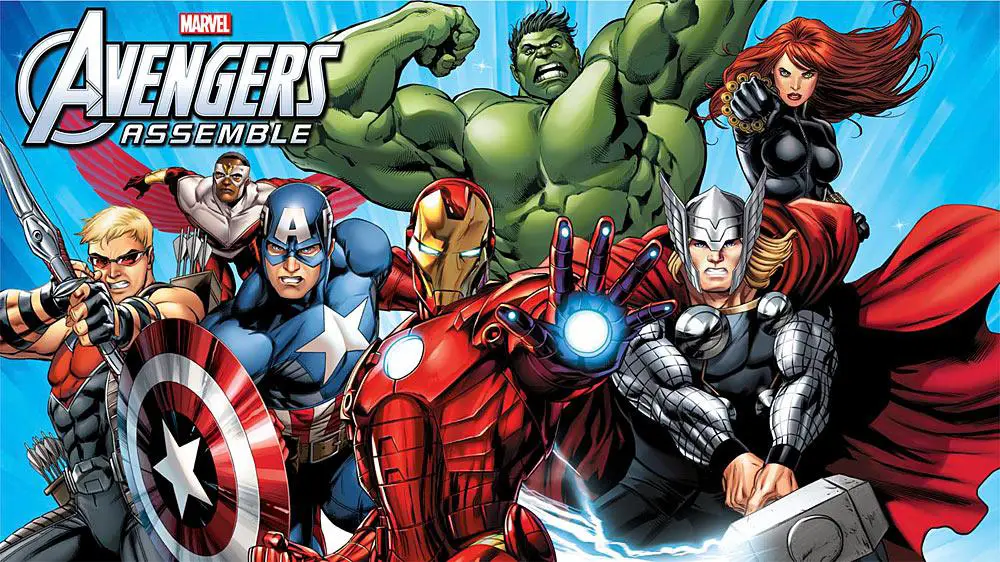I’ve talked a lot about the crazy science stuff writer Jonathan Hickman has introduced to the Marvel Universe throughout his Avengers and New Avengers books, as well as in the outer space epic event called Infinity. But this week another book centered around Earth’s Mightiest Heroes came to a close, one that itself didn’t shy away from weird happenings inspired by true fact.
Avengers Assemble was introduced to the comics pantheon in 2012 with self-contained stories originally focused on the team featured in the mega-blockbuster Avengers film of the same year, in the hope of attracting some of those inspired millions back to the source material itself. The new book launched to fanfare, with superstar writer Brian Michael Bendis at the helm.

Bendis only stayed on for eight issues, though; just long enough to reintroduce the Mad Titan, Thanos, to readers –- although moviegoers might recognize him better as the “Mad Grinner” in the celluloid
Avengers post-credit sequence. Current
Captain Marvel scribe Kelly Sue DeConnick took over at that point and steered the book in a slightly different direction, choosing instead to spotlight lesser characters like Spider-Woman and the newly-elevated Carol Danvers herself. All New Marvel NOW! series
Avengers World now follows a similar character-driven mandate, and as such,
Avengers Assemble has been retired as of issue #25.
DeConnick’s very first story for the series revolved around the discovery of ancient, never-before-seen bacteria from deep within Antarctica’s subglacial Lake Vostok, organisms that had been buried under more than 12,000 feet of ice since before human beings existed. As all such things go in the Marvel Universe, the tiny wonders were quickly weaponized by an evil figure looking to gain power.

Bruce Banner’s timeline there is pretty good, and a Russian team of scientists
did indeed find a bunch of microbial species in water samples recovered from Lake Vostok in 2012. Their results have since been heavily questioned, though, as the drilling methods are not considered by many to have been sterile enough to avoid contamination by known, surficial species. Perhaps a more clear cut success story is that of
Lake Whillans, another subglacial environment which was sampled more carefully by Montana State University’s John Priscu and the
WISSARD project last winter. That examination more unequivocally identified bacteria and other microscopic organisms, though nothing really that upset any of our previous knowledge.

The Russian team at Vostok (prematurely?) celebrates its discovery. Unlike the ‘Avengers Assemble’ antagonist and Vladimir Putin, none of them became supervillains.In the subsequent Black Widow-centered story arc, the former Soviet super spy travels to Russia (seriously, what is it with these guys and weird science?) in search of a missing child and ends up uncovering a den of genetically-altered lizard people. Natasha becomes part of the problem when Hawkeye and Spider-Woman are focred to turn her into one of the creatures to save her life after being mortally wounded.
The team’s initial concern, before being confronted by the super-strangeness, is that the lost girl has been victimized by the gruesome drug called “krokodil,” a real-life morphine derivative – proper name desomorphine – that was first used recreationally in Russia but has since found its way stateside. Much like the American crystal meth plague, desomorphine can be synthesized from over-the-counter medications, but rather than tweaking and losing teeth, krokodil users often experience skin inflammation that resembles the appearance of reptilian scales, without the near-magical healing powers. The damage is caused by impurities introduced in the production process, such as kerosene or gasoline.

This guy’s probably more likely to suck your dick for a fix than he is to attack Spider-Man. From guardianlv.comDeConnick’s final
Avengers Assemble tale utilizes a charcter she created for the 2010 mini-series
Osborn, which followed Norman’s incarceration after being removed from power at the end of the
Dark Reign status quo reset. June Covington, the Toxie Doxie, was one of Osborn’s fellow inmates, a brilliant biologist who made the ethically dubious decision to genetically experiment on herself, acquiring vicious abilities like antiseptic breath and a powerful neurotoxin that flows through her veins.

‘Avengers Assemble’ #21Genetic modification of organisms has gone on for centuries.
Selective breeding has brought us most of our current food crops as well as the myriad
designer dog varieties in our pet shops. So the backlash against more controlled outcomes through the use of modern genetic modification techniques is somewhat perplexing, since it’s really just a more deliberate version of practices no one batted an eye at for hundreds of years, and the
broad scientific consensus is that such “genetically modified organisms” pose no greater threat to human health.

GMO opponents know how to manipulate people’s emotions and fears. Image with an agenda from nutritiondenver.comHuman genetic engineering is a bit dicier. We should all be able to agree that
more nutritional rice is a good thing, and even that making adults
less susceptible to disease is desirable, but what about altering a fetuses genetic traits in utero? Or using the techniques for more cosmetic reasons, like a cellular-level plastic surgery? These are creepy ideas that will need to be further discussed in real life, and they make for even creepier fiction when at the disposal of a callous, comic book sociopath.


Join the AIPT Patreon
Want to take our relationship to the next level? Become a patron today to gain access to exclusive perks, such as:
- ❌ Remove all ads on the website
- 💬 Join our Discord community, where we chat about the latest news and releases from everything we cover on AIPT
- 📗 Access to our monthly book club
- 📦 Get a physical trade paperback shipped to you every month
- 💥 And more!
Sign up today

Sign up for our newsletter



















